Modeling Unpredictable Behavior of Energy Facilities to Ensure Reliable Operation in a Cyber-Physical System
Abstract
:1. Introduction
2. Methodology
2.1. Initial Conditions and a Basic Model of a Random Process of Operation of a Heating Source (with the Example of CHPP)
2.2. Modeling the Evolution of States Given Non-Ordinary Events
2.3. Modeling the Evolution of States Given the Dependent Events
3. Results of Computational Experiments
4. Discussion and Conclusions
Author Contributions
Funding
Data Availability Statement
Acknowledgments
Conflicts of Interest
Copyright
References
- Hao, Z.; Di Maio, F.; Zio, E. A sequential decision problem formulation and deep reinforcement learning solution of the optimization of O&M of cyber-physical energy systems (CPESs) for reliable and safe power production and supply. Reliab. Eng. Syst. Saf. 2023, 235, 109231. [Google Scholar]
- Konstantopoulos, G.; Alexandridis, A.; Papageorgiou, P. Towards the Integration of Modern Power Systems into a Cyber–Physical Framework. Energies 2020, 13, 2169. [Google Scholar] [CrossRef]
- Haack, J.; Narayan, A.; Patil, A.D.; Klaes, M.; Braun, M.; Lehnhoff, S.; de Meer, H.; Rehtanz, C. A Hybrid Model for Analysing Disturbance Propagation in Cyber–Physical Energy Systems. Electr. Power Syst. Res. 2022, 212, 108356. [Google Scholar] [CrossRef]
- Ribas Monteiro, L.F.; Rodrigues, Y.; Zambroni de Souza, A. Cybersecurity in Cyber–Physical Power Systems. Energies 2023, 16, 4556. [Google Scholar] [CrossRef]
- Merenkov, A.; Khasilev, V. Theory of Hydraulic Circuits; Nauka: Moscow, Russia, 1985. (In Russian) [Google Scholar]
- Kim, I.; Kim, B.; Sidorov, D. Machine Learning for Energy Systems Optimization. Energies 2022, 15, 4116. [Google Scholar] [CrossRef]
- Sennova, E.; Smirnov, A.; Ionin, A. Reliability of Heat Supply Systems; Nauka: Novosibirsk, Russia, 2000. (In Russian) [Google Scholar]
- Wang, J.-J.; Fu, C.; Yang, K.; Zhang, X.-T.; Shi, G.-H.; Zhai, J. Reliability and availability analysis of redundant BCHP (building cooling, heating and power) system. Energy 2013, 61, 531–540. [Google Scholar] [CrossRef]
- Lisnianski, A.; Elmakias, D.; Hanoch, B. A multi-state Markov model for a short-term reliability analysis of a power generating unit. Reliab. Eng. Syst. Saf. 2012, 98, 1–6. [Google Scholar] [CrossRef]
- Haghifam, M.; Manbachi, M. Reliability and availability modelling of combined heat and power (CHP) systems. Int. J. Electr. Power Energy Syst. 2011, 33, 385–393. [Google Scholar] [CrossRef]
- Sabouhi, H.; Abbaspour, A.; Fotuhi-Firuzabad, M.; Dehghanian, P. Reliability modeling and availability analysis of combined cycle power plants. Int. J. Electr. Power Energy Syst. 2016, 79, 108–119. [Google Scholar] [CrossRef]
- Shua, L.; Chena, L.; Jina, J.; Yu, J.; Sun, F.; Wu, C. Functional reliability simulation for a power-station’s steam-turbine. Appl. Energy 2005, 80, 61–66. [Google Scholar] [CrossRef]
- Abud, T.; Augusto, A.; Fortes, M.; Maciel, R.S.; Borba, B.S.M.C. State of the Art Monte Carlo Method Applied to Power System Analysis with Distributed Generation. Energies 2023, 16, 394. [Google Scholar] [CrossRef]
- Sennova, E.; Sidler, V. Mathematical Modeling and Optimization of Developing Heat Supply Systems; Nauka: Novosibirsk, Russia, 1987. (In Russian) [Google Scholar]
- Lund, H.; Østergaard, P.; Chang, M.; Werner, S.; Svendsen, S.; Sorknæs, P.; Thorsen, J.E.; Hvelplund, F.; Mortensen, B.O.G.; Mathiesen, B.V.; et al. The status of 4th generation district heating: Research and results. Energy 2018, 164, 147–159. [Google Scholar] [CrossRef]
- Revesz, A.; Jones, P.; Dunham, C.; Davies, G.; Marques, C.; Matabuena, R.; Scott, J.; Maidment, G. Developing novel 5th generation district energy networks. Energy 2020, 201, 117389. [Google Scholar] [CrossRef]
- Kallert, A.; Egelkamp, R.; Bader, U.; Münnich, D.; Staudacher, L.; Doderer, H. A multivalent supply concept: 4th Generation District Heating in Moosburg an der Isar. Energy Rep. 2021, 7, 110–118. [Google Scholar] [CrossRef]
- Buffa, S.; Soppelsa, A.; Pipiciello, M.; Henze, G.; Fedrizzi, R. Fifth-Generation District Heating and Cooling Substations: Demand Response with Artificial Neural Network-Based Model Predictive Control. Energies 2020, 13, 4339. [Google Scholar] [CrossRef]
- Huber, D.; Illyés, V.; Turewicz, V.; Götzl, G.; Hammer, A.; Ponweiser, K. Novel District Heating Systems: Methods and Simulation Results. Energies 2021, 14, 4450. [Google Scholar] [CrossRef]
- Brange, L.; Englund, J.; Lauenburg, P. Prosumers in district heating networks—A Swedish case study. Appl. Energy 2016, 164, 492–500. [Google Scholar] [CrossRef]
- Zinsmeister, D.; Licklederer, T.; Christange, F.; Tzscheutschler, P.; Perić, V.S. A comparison of prosumer system configurations in district heating networks. Energy Rep. 2021, 7, 430–439. [Google Scholar] [CrossRef]
- Gross, M.; Karbasi, B.; Reiners, T.; Altieri, L.; Wagner, H.-J.; Bertsch, V. Implementing prosumers into heating networks. Energy 2021, 230, 120844. [Google Scholar] [CrossRef]
- Mednikov, A.; Maksimov, A.; Tyurina, E. The Modular Plant Based on Biomass for Energy Supply of an Isolated Consumer: Mathematical Modeling. In Proceedings of the 2020 International Multi-Conference on Industrial Engineering and Modern Technologies (FarEastCon 2020), Vladivostok, Russia, 6–9 October 2020; pp. 1–5. [Google Scholar]
- Wang, D.; Carmeliet, J.; Orehounig, K. Design and Assessment of District Heating Systems with Solar Thermal Prosumers and Thermal Storage. Energies 2021, 14, 1184. [Google Scholar] [CrossRef]
- Postnikov, I.; Stennikov, V.; Penkovskii, A. Prosumer in the district heating systems: Operating and reliability modeling. Energy Procedia 2018, 10, 2530–2535. [Google Scholar] [CrossRef]
- Penkovskii, A.; Stennikov, V.; Kravets, A. Bi-level modeling of district heating systems with prosumers. Energy Rep. 2020, 6, 89–95. [Google Scholar] [CrossRef]
- Stanica, D.-I.; Bachmann, M.; Kriegel, M. Design and performance of a multi-level cascading district heating network with multiple prosumers and energy storage. Energy Rep. 2021, 7, 128–139. [Google Scholar] [CrossRef]
- Li, H.; Hou, J.; Tian, Z.; Hong, T.; Nord, N.; Rohde, D. Optimize heat prosumers’ economic performance under current heating price models by using water tank thermal energy storage. Energy 2022, 239, 122103. [Google Scholar] [CrossRef]
- Li, H.; Hou, J.; Hong, T.; Nord, N. Distinguish between the economic optimal and lowest distribution temperatures for heat-prosumer-based district heating systems with short-term thermal energy storage. Energy 2022, 248, 123601. [Google Scholar] [CrossRef]
- Postnikov, I. Methods for optimization of time redundancy of prosumer in district heating systems. Energy Rep. 2020, 6, 214–220. [Google Scholar] [CrossRef]
- Postnikov, I. Methods for the reliability optimization of district-distributed heating systems with prosumers. Energy Rep. 2023, 9, 584–593. [Google Scholar] [CrossRef]
- Ross, S.M. Introduction to Probability Models, 12th ed.; University of Southern California: Los Angeles, CA, USA, 2019. [Google Scholar]
- Stennikov, V.; Novitsky, N.; Alexeev, A.; Grebneva, O.; Lutsenko, A.; Penkovsky, A.; Postnikov, I.; Tokarev, V.; Shalaginova, Z.; Mednikova, E.; et al. Chapter 6—Hierarchical modeling of analysis control of operating conditions of pipeline energy systems. In Hierarchical Modeling of Energy Systems; Voropai, N.I., Stennikov, V.A., Eds.; Elsevier: Amsterdam, The Netherlands, 2023; pp. 379–455. [Google Scholar]
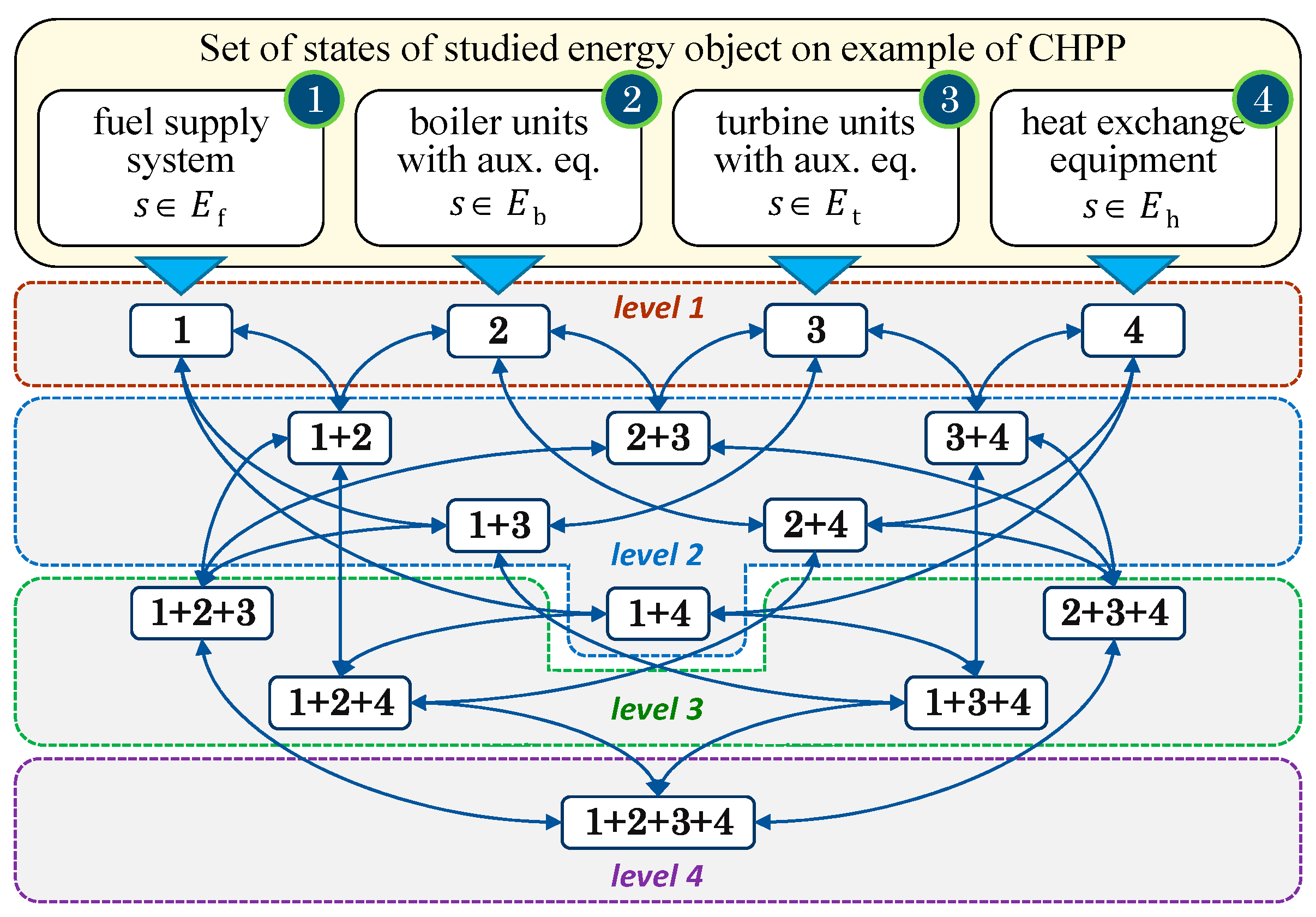
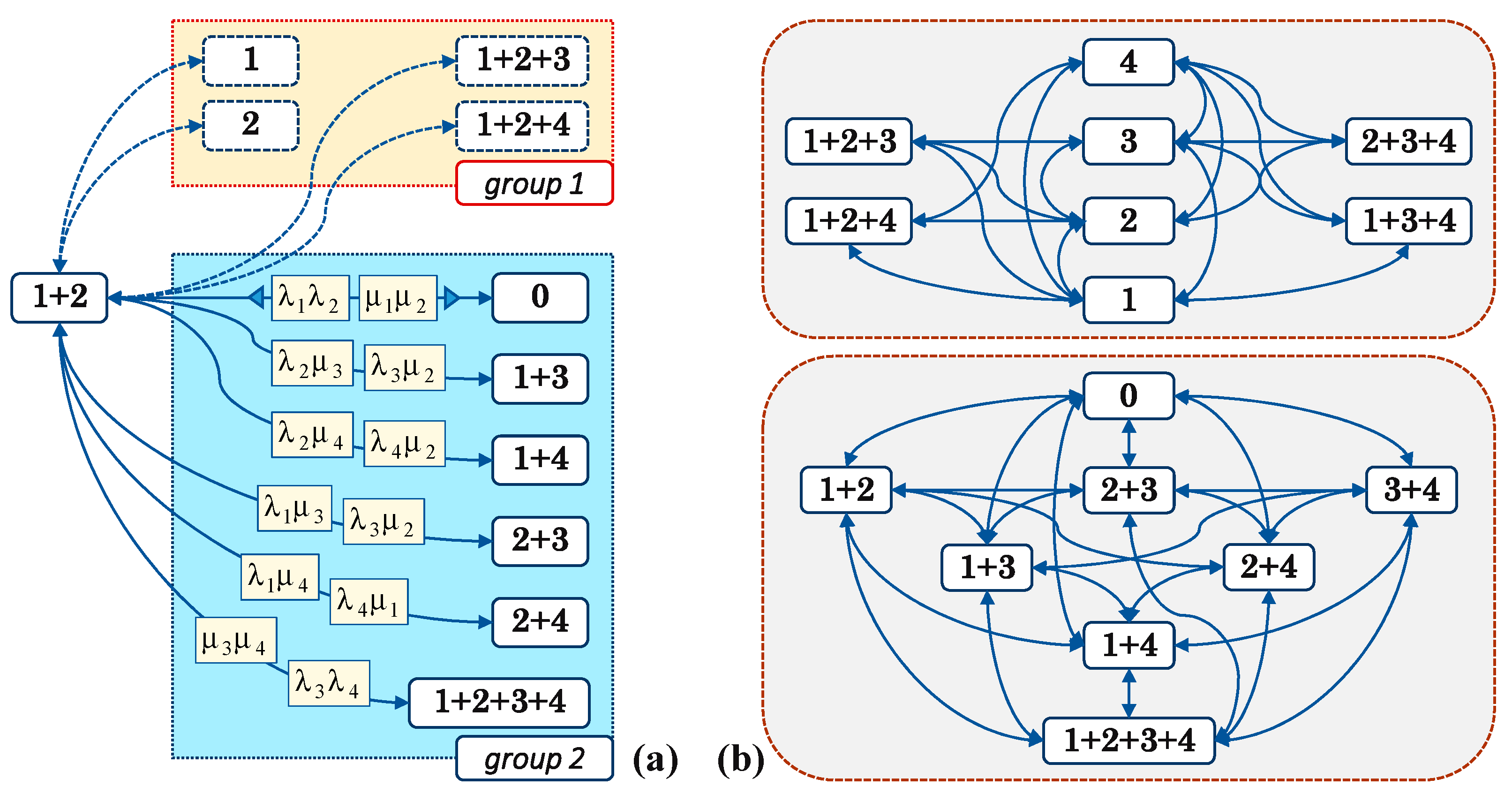

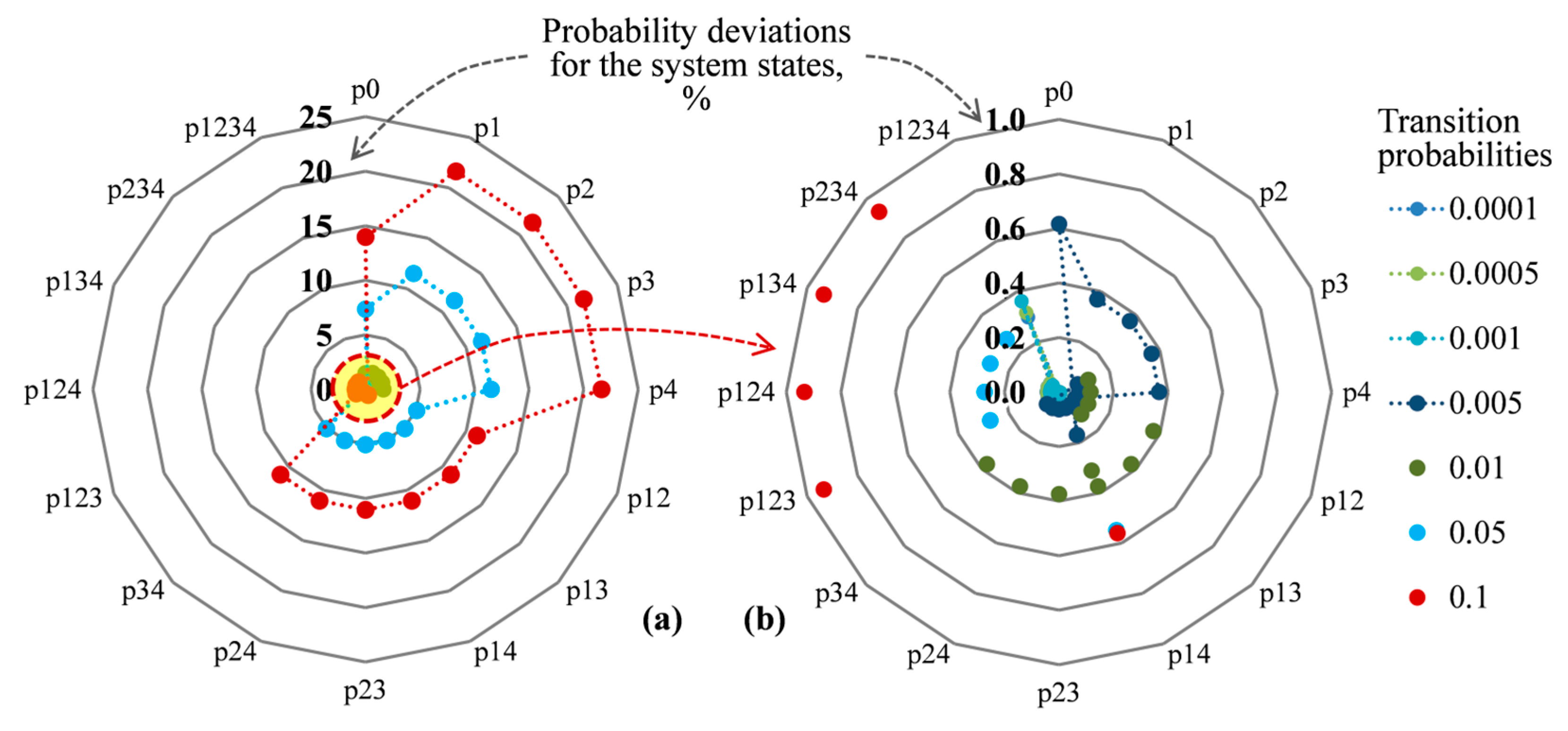
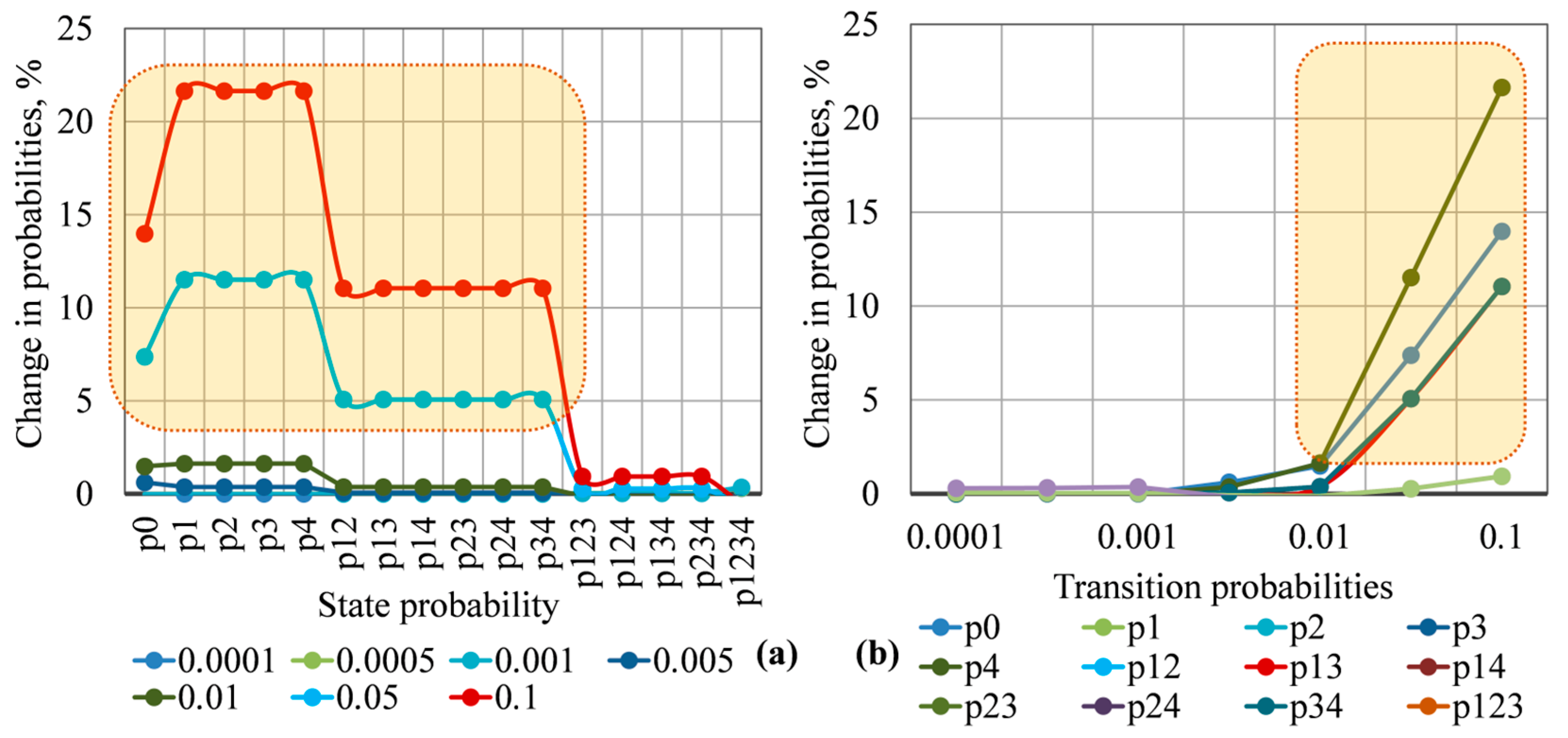
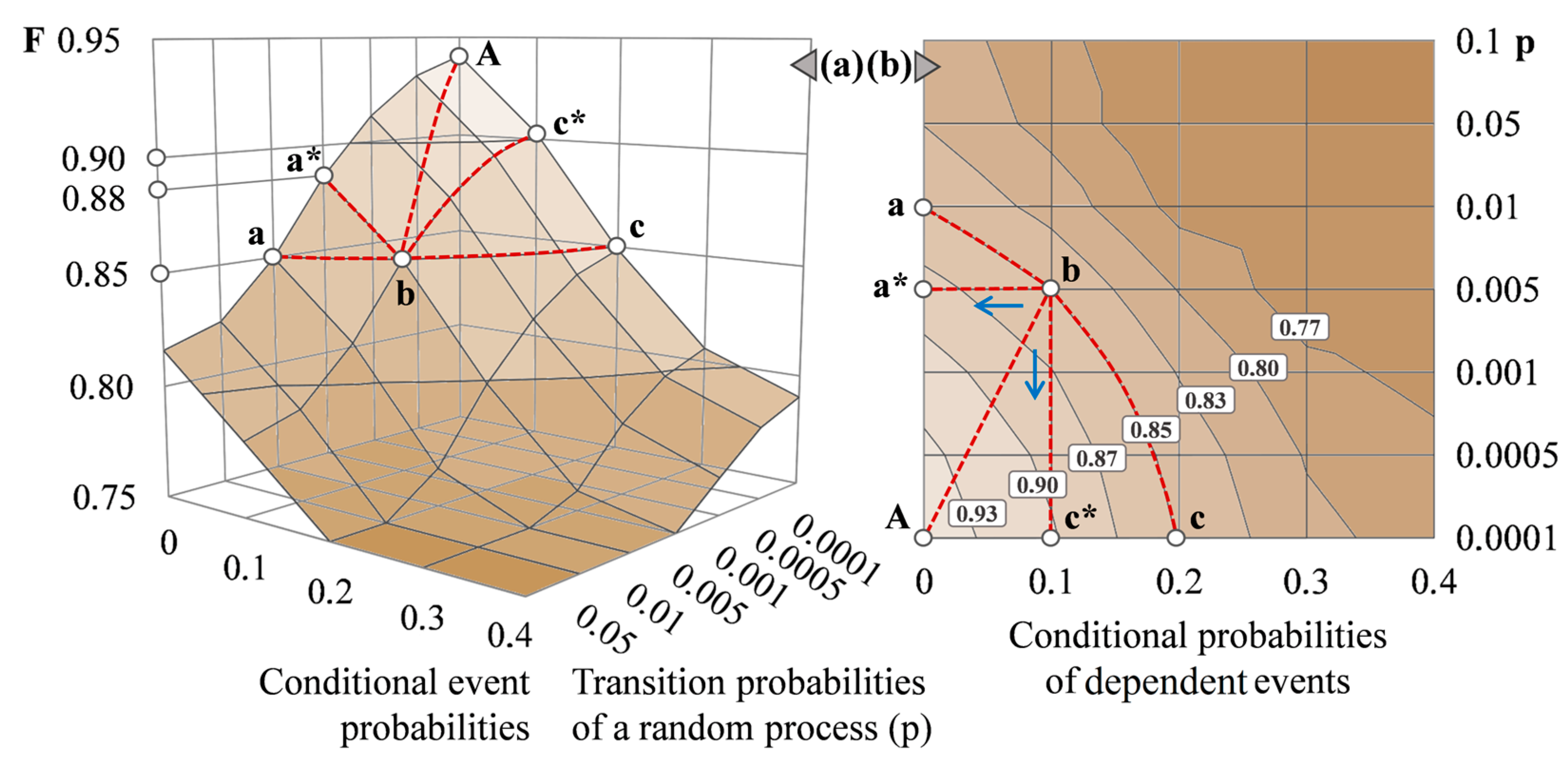
Disclaimer/Publisher’s Note: The statements, opinions and data contained in all publications are solely those of the individual author(s) and contributor(s) and not of MDPI and/or the editor(s). MDPI and/or the editor(s) disclaim responsibility for any injury to people or property resulting from any ideas, methods, instructions or products referred to in the content. |
© 2023 by the authors. Licensee MDPI, Basel, Switzerland. This article is an open access article distributed under the terms and conditions of the Creative Commons Attribution (CC BY) license (https://creativecommons.org/licenses/by/4.0/).
Share and Cite
Postnikov, I.; Samarkina, E.; Penkovskii, A.; Kornev, V.; Sidorov, D. Modeling Unpredictable Behavior of Energy Facilities to Ensure Reliable Operation in a Cyber-Physical System. Energies 2023, 16, 6960. https://doi.org/10.3390/en16196960
Postnikov I, Samarkina E, Penkovskii A, Kornev V, Sidorov D. Modeling Unpredictable Behavior of Energy Facilities to Ensure Reliable Operation in a Cyber-Physical System. Energies. 2023; 16(19):6960. https://doi.org/10.3390/en16196960
Chicago/Turabian StylePostnikov, Ivan, Ekaterina Samarkina, Andrey Penkovskii, Vladimir Kornev, and Denis Sidorov. 2023. "Modeling Unpredictable Behavior of Energy Facilities to Ensure Reliable Operation in a Cyber-Physical System" Energies 16, no. 19: 6960. https://doi.org/10.3390/en16196960
APA StylePostnikov, I., Samarkina, E., Penkovskii, A., Kornev, V., & Sidorov, D. (2023). Modeling Unpredictable Behavior of Energy Facilities to Ensure Reliable Operation in a Cyber-Physical System. Energies, 16(19), 6960. https://doi.org/10.3390/en16196960







